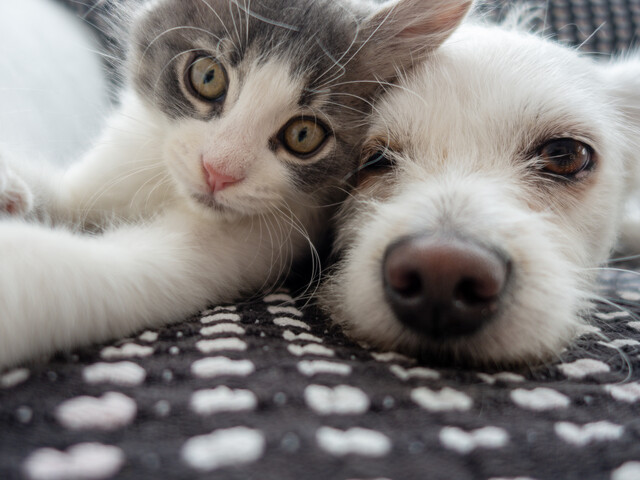You have everything organized, you have all your gear, and you are ready to get going. The next step is getting those new clients! Marketing your business effectively is crucial to your success. There is a variety of ways to get the word out about your new enterprise. By taking advantage of several of them, you can ensure that you quickly increase your client base and establish a solid reputation.
Logo and Slogan
You will need a consistent look for everything from your business cards, to your rate sheets, and invoices to look professional. To make your business memorable and clearly indicate what type of service you provide, use a logo that incorporates animals somehow, yet is distinctive enough to be unmistakably you. First, this need not be expensive. You can use simple clip art to dress things up, but as your income increases consider investing in a unique logo that will set you apart from others and is uniquely yours. Having a distinct, immediately recognizable logo is a huge advertising advantage.
A tagline or slogan that captures the flavor of what your pet sitting or dog walking service is all about is also a good idea to include on all of your paperwork and advertising. It ties your name and a positive message together in prospective clients' minds. It can be as simple as "Prestige Pet Sitting, Custom Care for Your Precious Ones," but if you have it on your business cards, brochures, and advertising, it will soon link your company with customized pet care in everyone's mind automatically.
Advertising
There is a variety of advertising routes to take to get your business name out there. Start with listing your service where most people look when they need your service at the last minute, the Yellow Pages. Telephone books are still an inexpensive use of your advertising dollars and you can get a large advertisement for not much money. Do not get just a standard listing or you will be lost in the crowd. Look at what others have and try to match the best for size and use of color. Highlight one or two of your best or unique qualities and make sure that you remember to include your website address as well as your telephone number.
Brochures
Brochures can be a basic one page sheet, a tri-fold, bi-fold�almost any style you want. The beauty of making an interesting brochure is the versatility. You can display brochures almost anywhere. Introduce yourself to area groomers, veterinarians, and shelters and get to know them. Ask if you can display some of your brochures in their office or waiting room, and be sure to offer to do the same for them. Also, it is a good idea to help them out in some way. For instance, you might want to volunteer to walk some of the shelter dogs twice a month. They will be very grateful for your assistance and will be much more likely to recommend you to new adoptive parents if you are an active volunteer. Networking is never a one way street!
A brochure is the opportunity to elaborate on some information. Be sure to include some additional facts and data that bolster the importance of using your service as well as some tips for pet owners. Some information that you might consider including in a tri-fold brochure could be:
|
� Information on your various professional membership affiliations. � Tips on how to prepare a pet for their first visit from a pet sitter or their first dog walking excursion. � Answers to frequently asked questions. � Why you went into the pet care business. � The advantages of pet sitting over kennels. � A discount coupon for the first visit or dog walking session. |
Newspapers
Newspaper advertisements are also nice, but call first to do some research. Ask if there will be any upcoming special editions focusing on animals, community services, or any other topic that might be particularly appropriate. Running an ad in a special edition serves you better in two ways, you are targeting readers who are more likely to be interested in your service, and circulation generally increases for special editions.
When you look into newspaper advertising, do not limit yourself to the town's daily newspaper. In many communities today, many people also get a Sunday edition that covers the county or a particular region. These may draw your clientele from neighboring towns if you are willing to cover a particular geographic area within ten to fifteen miles. There may also be small periodicals in your community that are published weekly or monthly such as municipal newsletters or civic group periodicals. These usually offer extremely low advertising rates and are glad to have the support of local businesses.
You can also submit press releases periodically to newspapers, but be sure to only take this route when you have a truly newsworthy item. Newspapers are always glad to receive filler information they can use, but they hate to get what is essentially an advertisement disguised as a press release. A press release can be submitted for the grand opening of your business, any time you win an award, are involved in a charitable event, or when you achieve a milestone of note.
Support Your Local Schools
High School sports, theater, and bands have special events each year and publish programs that have advertising space in them. Take a look in your community. You will see pages that have ads in football programs that read, "Manning Insurance wishes the Lakefield Raiders a Winning Season!" You will be quickly noticed by pet owners and football fans in your town if you purchase an ad that says, "Everyone at Prestige Pet Sitting Wishes the Lakefield Raiders a Howling Good Season!"
Be sure to make your support for school activities fair, rather than one large ad for sports, invest in a reasonably sized ad for sports so that you can also buy one for the school play and the holiday band concert. Do your homework and find out what the big events are for each of the school's major activities and support them accordingly; you want to reach pet owners from all walks of life.
A Website
You do not have to have a website to start your pet sitting or dog walking business, but you will probably want to have one eventually. There are a number of reasons to have one, not the least of which is because more and more people search for services on the Internet instead of using the Yellow Pages these days. You want to be the service they find!
A basic website can have a single page with your services listed and contact information at first. Later, you may want to add additional pages with more information that is detailed, interesting facts, and a contact page so that potential clients can email you or make appointments online. A frequently asked questions page is also a good way to address any concerns visitors might have about using a pet sitter or dog walker for the first time.
Promotions
Promotions are items such as coupons, discounts, or special events that are incentives or a thank you. You can get creative with promotions and have quite a bit of fun with these. One dog walker gave every new client a free dog tag for the dog's collar that was engraved on one side with the dog's name, address, and phone number on it and "Courtesy of Prestige Pet Sitting" on the reverse.
Gift Certificates
You can order gift certificates online or from a local print shop that come in duplicate form so that you will have a copy for your records. These make lovely holiday gifts for any number of people and you should suggest these to your current clients. What about busy young couples who both work? A few weeks of dog walking for the pet would surely be appreciated. It is also a great idea around the holidays, when many people are busy getting ready for company and may have less time for walking their dog on a regular basis. If a retired couple loves to travel but hates to board their beloved pet, a gift certificate for pet sitting is a great gift that lets them take a vacation without worry.
You can also donate gift certificates when organizations ask you to donate prizes. When you can donate a gift certificate for a service, you will often get more than your money back from the new clientele you cultivate. For a nice touch, include a small pet toy with the gift certificate.
Referral Discounts
50 percent off his next pet sitting contract. Determine what you can afford to offer and be sure you get out the word. Print it on your Invoices and your Client Service Contracts.
When Opportunity Knocks
Make opportunity happen as well. Many grade schools now have safety days when they teach kids about fire safety and home safety. Approach the principal at the beginning of the school year and suggest a brief talk about safety around animals and the importance of teaching children how to avoid being bitten or attacked by a dog. If you can bring a dog into the parking lot, great! If not, you can certainly do a classroom talk showing the appropriate way to approach a dog, how to avoid startling an animal, and more, without a live animal present.
Meeting Your Clients
The First Contact
Your first contact from a potential client may not be face-to-face. In most cases, they will call you first to ask for information. Be open, honest, and friendly. Always ask what kind of pet or pets they have and what are their names. From there, ask about the pet's breed and age and perhaps contribute something about your experience with that type of animal or breed. For instance, if someone calls asking about pet sitting for their cat and parrot, they will certainly appreciate hearing how much you enjoyed the last parrot you worked with.
As a pet care provider you will often not be available to answer your business phone, so be sure to have a good quality answering machine. Your outgoing message should include your name, your company name, and an invitation to leave a brief message with a promise you will get back to them quickly. Then return any messages within 24 hours, always! If not, potential clients are likely to move on to someone else. A good answering message might sound like this:
"Hello, thank you for calling Prestige Pet Sitting. This is Todd. I am sorry I cannot come to the phone right now, but I am either rubbing a puppy's belly or feeding someone's cat right now. If you will leave your name and phone number, I will be sure to call you back as soon as I get in! Thanks again for calling Prestige Pet Sitting!"
The First Meeting
Once you have scheduled an initial meeting with a potential client, you are probably well on your way to having the job, but never assume anything. Until a client has seen you interact with their pet or pets nothing is a given. You should be professional at all times when you are invited into a new client's home. Have all of the forms you need in a tote bag or nice folio and be sure you have a pen with you so that you do not have to go digging around for one when it comes time for signatures on the contract and filling out forms.
Introduce yourself, thank the client for their time, and briefly explain how your pet sitting or dog walking service works. If the animal you will be working with is in the room, allow the dog/cat/whatever to approach you first rather than force yourself on him or her. You can put you hand out (palm down, which is non-threatening) to let the animal get a sniff, but go slowly until you are sure he or she has warmed up to you. Once the animal has, pet him and let him know in a warm voice how good he is.
|
Quick Tip Sherry always tucked a few photos showing her with her own pets (two dogs, a cat, and a lizard) into her portfolio when she went to her first meeting with clients. They were wonderful icebreakers and showed clearly her love of all types of creatures. At the end of each interview, she left behind a business card, brochure, and a sheet with photos of her with happy animals that she had cared for in the past alongside notes from their owners thanking her for a job well done. |
The Client and Pet Information Form (Again)
If you have had the chance to begin the Client and Pet Information Form during an earlier phone conversation, now is the time to pull out this form and review the information you already have with the client to confirm it. The client should be impressed that you remember the earlier conversation and were taking notes at that time. Ask them to fill out the rest of the information while you are acquainted with their pet. If you have a biscuit or treat with you, ask permission before offering one to the pet, if permitted, a biscuit is a great bonding tool!
Once the form is completed by the client, go over it briefly with the client to make sure you understand all the information and ask any questions that you may have concerning special instructions, medical conditions, or anything else unusual. This is also a good time to ask the client ifthey have any questions for you. Answer any questions that they have thoroughly and be honest about how you will handle any circumstances that may arise.
Several topics that you should cover at an initial Client interview include:
|
� The fact that you are fully insured. � Your fees and payment schedule. � The schedule the client wants for services. � The need for all pets to be current with vaccinations and your need to have proof of vaccination from their veterinarian for your records.* � The contract and its contents. � Any medical or anxiety problems the pet(s) have and how you should handle them. |
*The requirement for current vaccinations is particularly important when you will be walking dogs. This is something you should never negotiate or let slide. If a dog in your care should bite someone or pass on an illness such as kennel cough or Parvo Virus to another dog in your care, you can be liable for exposing a person to the need for rabies shots or other animals to potential death or expensive treatments. DO NOT TAKE THIS CHANCE.
Your clients may want you to spend some time with their pets so they can observe how well you work with them. This is fine within reason, remember, you are not being paid for the initial interview, but taking a short 15-minute walk with the dog and his master is a nice way to get to know them and show the client how well you work with your charges. It also gives you the chance to see how well the new dog responds to commands and if he will be difficult to handle on a leash.
A brief play session rather than a walk may be all that is needed for pet sitting. Do ask the client to show you around if you will also be watering plants, adjusting drapes, or other chores while they are away. While bonding with pets you will want to ask questions regarding the animal's disposition and behavior. This is particularly important for dog walkers, who frequently walk several dogs together and who belong to different clients. Stress to the client that they need to be completely honest, you are not judging the dog's character at all, but you do need to know how he or she will react to other animals in a group situation for everyone's safety. Questions you will want to ask (depending on the type of job and the situation) may include:
|
� How well does your dog get along with other dogs? � How does she respond to leash commands? � Will you allow your pet to be transported in my vehicle? � Is your dog spayed or neutered? * � Has your dog had any obedience training? � What time do you prefer to be scheduled for daily visits and walks? |
*In general, animals that are spayed or neutered are somewhat easier to handle. You will also not have to worry about proper care for females when they are in heat (you will not be able to walk them with male dogs) or making sure male dogs do not get loose or walk off leash. If you care for a dog that has not been spayed or neutered, it is best to let the owner know that you will not walk them in a group situation due to the increased risk of unwanted litters.
Closing the Deal
Once you have bonded with the pet(s) and the client is at ease, be sure to ask when they would like to start the dog walking or, alternatively, what time they would like you to make your first pet sitting visit. A concrete question is the easiest way to ease them into a commitment because it requires a specific answer. Once they say something like, "Well, what about Tuesday?" say, "Great! Let me get out a Contract and we can get everything set up!"
Explain the contract briefly and have both parties sign it, making sure it is properly filled out and dated. Your final step is making sure, if you are pet sitting, that you ask about how you want to handle entry to the house. Do not ever let a client suggest a key under the mat or some other arrangement. Stress that you will need to either regularly pick up the key from them or have a copy of the house key in order to protect the security of the home and the safety of their pets. You should also discourage relying a neighbor with keys; if they are not home when you show up or they change their plans, the pets will be uncared for through no fault of yours, but they will suffer nonetheless.
Caring for Customer Keys
If a client opts for you to pick up a key at the beginning of each week and drop it off at the end of each week, include a small surcharge for your effort. After all, you are going out of your way, using your time and gasoline to get the key from them and return it to them. If they give you a copy of their key, never, under any circumstances, make a copy of the key or allow anyone to use that key without the express permission of the homeowner.
You are responsible for the security of each customer's home when you have their keys in your possession. Do not ever have the name, address, or any other identifying feature of the homeowner attached to the keys that you carry. A number system or a color coding system attached to the keys with small tags is a simple and easy way to keep track of which keys go to which house. Of course, you should not keep the code to the system with the client names with the keys! Store the list of names with the number or color code in a safe place separate from the keys. Soon enough you will know which ones are which from memory.























